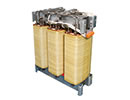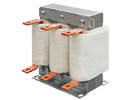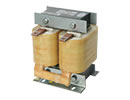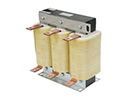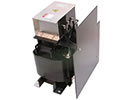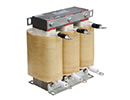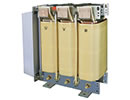- Laminated Busbar
- Film Capacitor
- Film Capacitor for HEV / EV Motor Control Unit
- DC-Link Capacitor ( Dry-Type, Plastic Case, Maximum Temperature 85℃)
- DC-Link Capacitor ( Dry-Type, Plastic Case, Maximum Temperature 105℃)
- MKP DC-Link Film Capacitor
- Water Cooled Heat Sink
- Flat Heat Pipe
- Reactor
- Water Cooling Reactor
- Input AC Reactor
- Output AC Reactor
- DC Reactor
- Reactor for Explosion-Proof Inverter
- Sine Wave Filter
- Detuned Reactor
- DV/DT Filters
- Three-Phase Input Filter
- Resistor
- Wirewound Resistor
- Aluminum Enclosure Resistor
- Aluminum Housed Resistor
- Die-Casting Aluminum Resistor
- Aluminium Resistor (Multiple Unit)
- Thick Film Resistor
- Braking Resistor Box
- Wirewound Tubular Fixed Resistor
- Power Resistor Unit
- Crowbar Resistor
- Braking Unit
Reactor
Reactors (inductors)
Reactor, also inductor, is a kind of electrical component mainly used to maintain current at constant levels by resisting any changes in the current.
Reactors/indicators are passive electronic components that have the ability to store energy in a magnetic field created by the electric current passing through it. They are designed to control current and voltage over a given period of time. The voltage is controlled by altering the associated magnetic fields i.e. changing the magnetic field strength. Inductance, which is the inductor's ability to store current, is measured in units called henries. The basic component of reactors or inductors is a coil of conducting material whose loops help create a strong magnetic field within the coil due to Faraday's law of induction. The coil has the property of high inductance and low resistance and is often coiled around a core, made of a suitable material such as soft iron.
Classifications of reactors/inductors
They include input AC Reactor, output AC Reactor, DC Reactor, Energy Regenerated Reactor, Tube Water Cooling Reactor and Detuned Reactor.
Working principle
An inductor can act either as a load or as a source.
It functions as a load when the current passing through it is increased. This involves dropping a voltage opposing the direction in which electrons are flowing. While carrying out this function, the amount of energy being stored in the magnetic field increases and this can be referred to as charging.
As a source, this is whereby the current passing through the inductor is decreased and it drops a voltage aiding the directions in which electrons are flowing. In this case, it acts as a source of power. In this function, the inductor is discharging because it is reducing the amount of energy being stored in its magnetic field.
Reactors use the Faraday's law of induction which states that the magnitude of the electromagnetic force induced in any closed circuit is equal to the time rate of change of the magnetic flux that cuts across the circuit. Here, the magnetic flux is the total effect/quantity of the magnetic field through space.
When an electric current passes through a reactor, a magnetic field is created around the coil. The more the current in the coil, the more the magnetic field hence the reactor will store more energy. Conversely, in order for the reactor to release energy, the current within the coil has to be decreased so as to have a weaker magnetic field. The measuring unit of the stored energy is joules and SI, which is equal to the magnetic field.
Inductors/reactors are at times referred to as transformers whose function is to slow the rate at which current is rising as well as to surpass noise. This is because transformers operate using the principle of mutual inductance.
Features
A reactor consists of a coil of conducting material usually made of copper wire which is wrapped around a core. The coils may be of various kinds: air coil, ferrite honeycomb coil, and toroidal core coils.
Functions of reactors
Their use in power circuits results in the creation of inductive reactance for a wide range of purposes. These include filtering of harmonic, inrush current limiting for motors and capacitors, limiting fault current, reducing ripple currents, load balancing, circuit de-tuning, flicker reduction for furnace applications, neutral grounding, provision of radio tuned circuits, as an energy storage device in some power supply units (PSU), among others.

